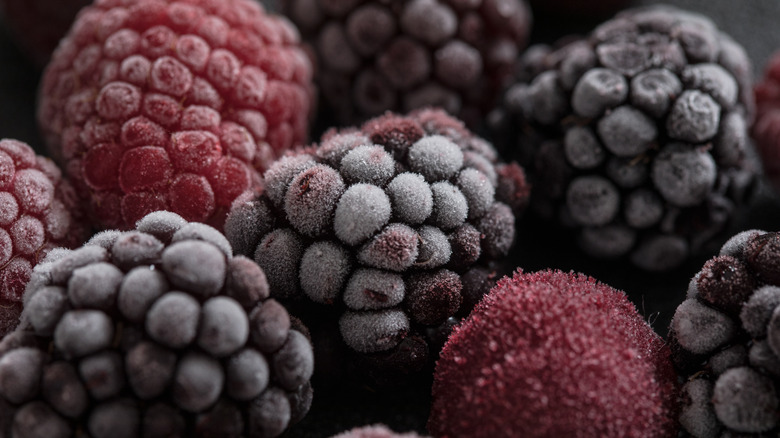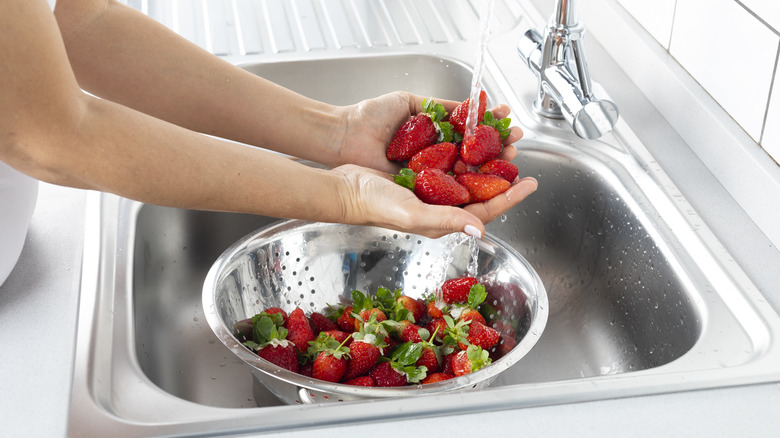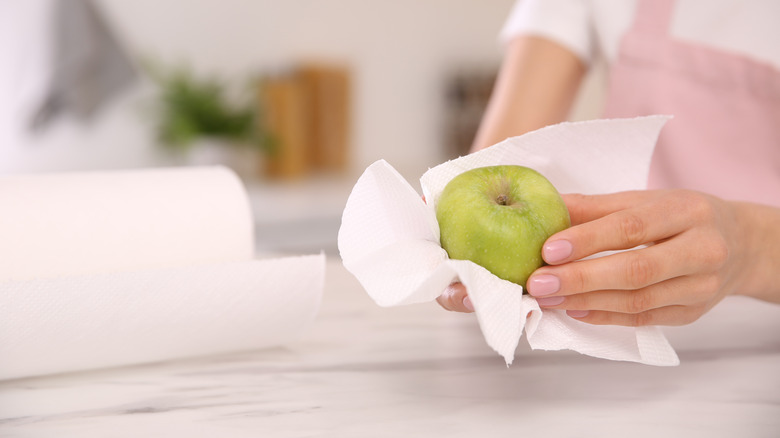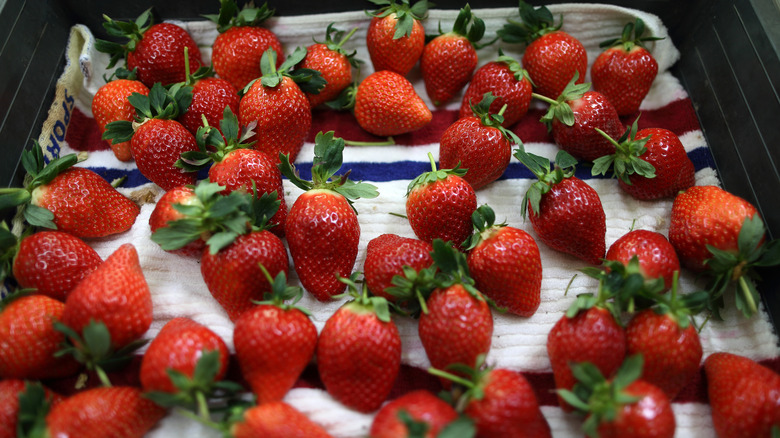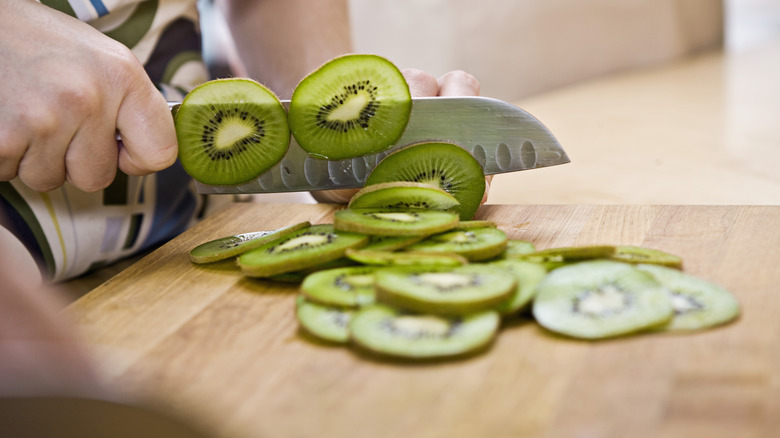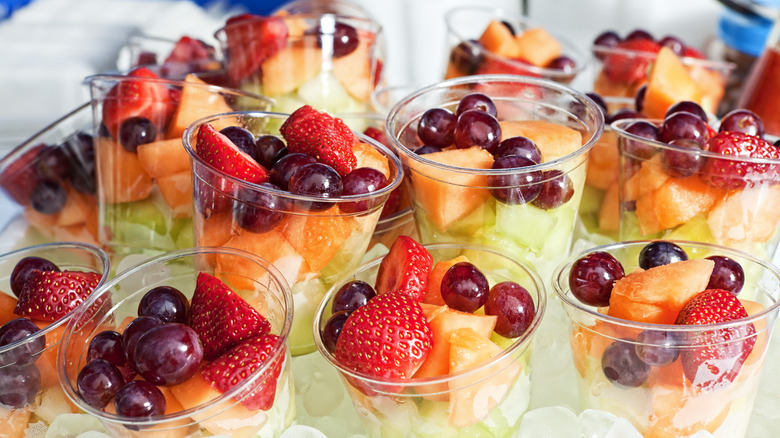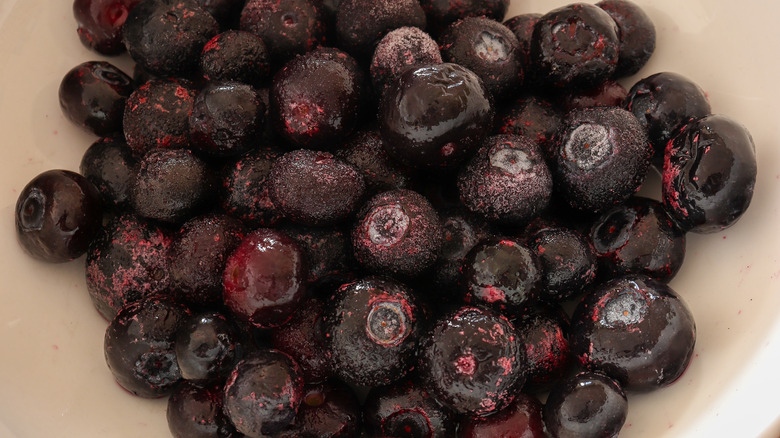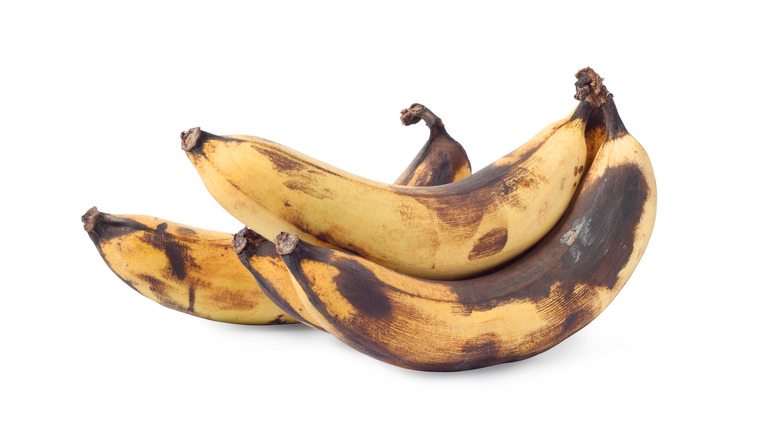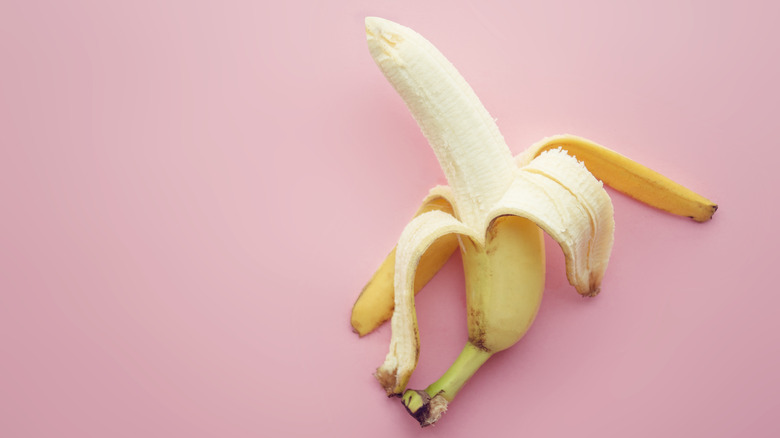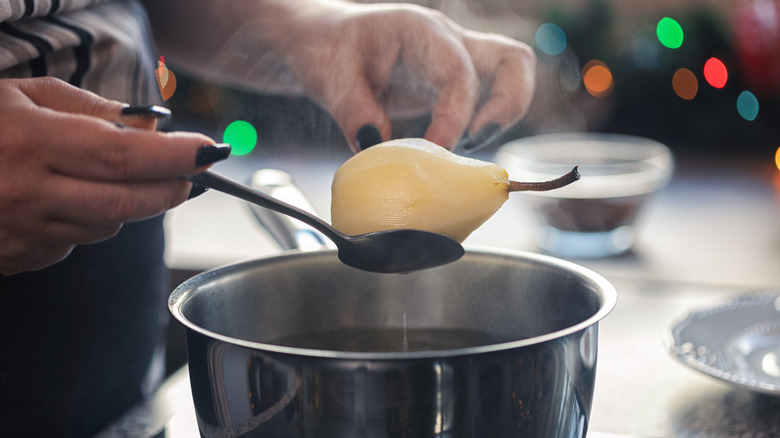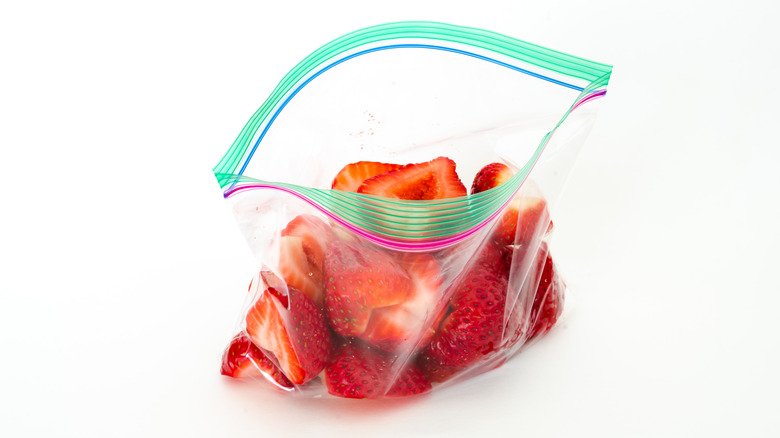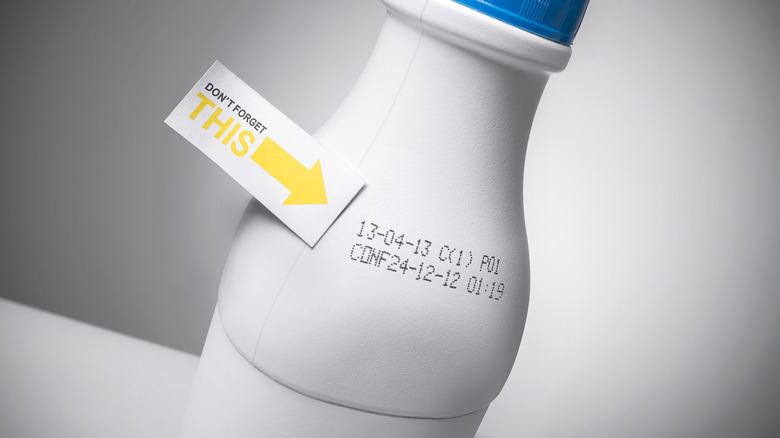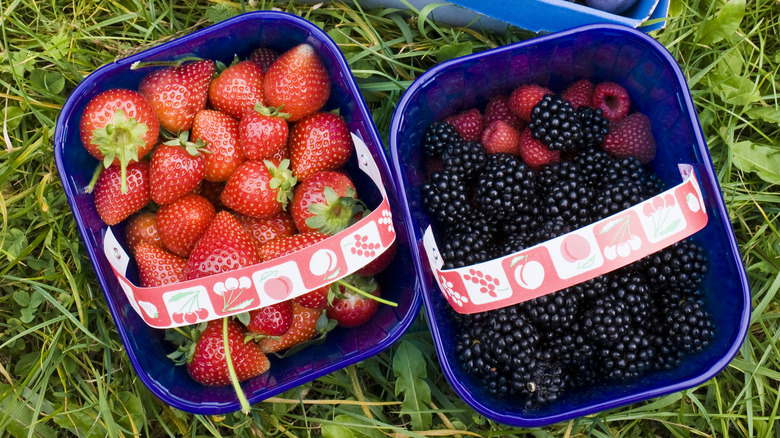Mistakes Everyone Makes When Freezing Fruit
Freezing fruit is a great way to preserve it when you have too much to eat out of hand before it spoils, and frozen fruit is a refreshing treat in the summer. And who doesn't love being able to eat their favorite fruit when it's out of season and no longer available in markets? Preserving fruit in a freezer is one of the easier preserving tasks that you can do, but you still have to know what you're doing. If you just throw fruit in a bag and let it sit in the freezer, you could end up with ruined fruit.
Ensuring the fruit stays in relatively good shape when frozen and thawed also preserves as much nutrition as possible. While you might not be flash-freezing food like large manufacturers can, you can have a good supply for months if you freeze it right. Luckily, it's easy to learn the do's and don'ts so you can avoid the mistakes everyone makes when freezing fruit.
Not cleaning the fruit first
Regardless of your views on washing fruit that you're about to eat, any fruit that you're going to freeze needs to be clean, for a couple of reasons. One is that it's harder to wash frozen dirt off frozen fruit. That dirt's not going anywhere until both it and the fruit thaw enough to separate. And if you let the fruit thaw, you risk crushing the fruit no matter how lightly you scrub the surface when you clean it. That only lets dirt, germs, and whatever else is on the surface seep into the fruit. Do you really want to have to spend time trying to clean icy fruit? Clean it before freezing so you can use it straight out of the freezer.
Cleaning the fruit beforehand also gives you a chance to sort it carefully, removing less desirable pieces, like those with apparent bug damage or mold. If you're freezing berries, you can separate them by size. The one warning here is that you want to wash and freeze the fruit relatively quickly after it has been harvested to retain the best quality.
Not drying the fruit thoroughly after cleaning
No matter what process you use to wash fruit, water's going to be involved somehow. A major mistake you can make is not letting the fruit dry completely before you attempt to freeze it. Wiping the water off the fruit or letting excess water drip off it for a couple of minutes in a colander aren't enough, although they are a start. Any moisture on the surface of the fruit will freeze once surrounded by those cold temperatures, and that may result in everything freezing together in a block.
After the washing is done, you can still wipe excess water off larger fruit and let smaller fruits sit in a colander. But then you need to take the drying a step further. For larger fruits like apricots, give them a good but gentle scrub with a dry paper towel. For smaller fruits like cherries and berries, place the fruit on paper towels in a single layer, and gently press another layer of paper towels on top of them. If you can, try to turn the fruits so that you can dry all sides. Let them sit for a bit to fully air-dry.
Not freezing it initially in a single layer
Placing fresh fruit all together in a bag or container and tossing it in the freezer actually won't result in a bag of individually frozen fruit. It'll result in a bag containing something that looks like a frozen bowling ball. And one that's very difficult to separate into smaller bits, we might add.
You can avoid this by using a method called a tray pack. Spread a single layer of fruit on a tray, place the tray in the freezer, and leave it alone for a short while, until the pieces appear mostly frozen. Pour them into a bag or container, and repeat the process with any other fruit you're trying to freeze. When you freeze the pieces in that single layer, you're letting any moisture freeze before the pieces come into contact with each other, and you end up with frozen fruit that isn't stuck in a big clump.
Not cutting large fruit up first
Space inside a home freezer is usually limited in some way due to both freezer size and to most of the space being taken up by other food. That calls for some chopping and slicing if you want to freeze something that's larger than a berry. Storage will be better organized if you break fruit down into smaller, more easily packed chunks.
Cutting up fruit has two additional advantages. One is that when you cut the fruit into pieces that are roughly the same size, they freeze at the same rate. If you're spreading the fruit out in a single layer to freeze, you won't have some of the fruit freezing well after the rest. That difference in freezing time can be the difference between having a bag full of individually frozen chunks and a bag with chunks still frozen together because you didn't want to wait for the larger pieces to freeze when in that single layer.
The other is that having uniform chunks stored together makes retrieving chunks of a specific size a breeze. If you know you need diced mango for a recipe, you won't have to dig out small dice from around larger spears and chunks. Of course you can freeze fruit in different sizes; just put the different sizes in different containers.
Not freezing it in portions
Make life easy on yourself and package frozen fruit in specific portions. Yes, you can measure out a portion of blueberries from a bag, but it's nice to know that you can grab a container and automatically have just enough berries for your recipe without having to measure. Freeze the fruit in the portion sizes that you regularly use, and ensure you have a few single-serving packs as well for when you're making a meal for just yourself.
Dividing fruit into specific portions helps tremendously if you're using a technique known as syrup pack or sugar pack. These involve packing the fruit with a sugar-based syrup or letting the fruit sit in sugar, which draws out juice and creates a syrup around the fruit. Once frozen, these blocks aren't easy to divide. And it should go without saying that purees need to be in portions. You are not going to like chipping away at a block of frozen pulp to get a smaller amount.
Expecting it to be the same once it's thawed
Thawed frozen fruit is mushy. Some fruits end up mushier than others, and some look way better or worse. If you search online, you'll find many sites offering advice on how to freeze fruit so that you can thaw it with a minimum of mush. Problem is, while freezing the fruit as quickly as possible does help, the nature of the fruit and its water-filled cells means that any freezing and thawing will change the fruit's texture no matter what you do to try and prevent it. Don't freeze and thaw fruit with the expectation that it will have the same mouthfeel, even if it looks OK. If you're not familiar with the term "mouthfeel," it describes how food feels in your mouth — the texture and how the food feels against all the surfaces in there.
Freezing can also change the fruit's color; in fact, you may want to include pre-freezing treatments to preserve the fruit's color. These include adding lemon juice or ascorbic acid, or even steaming some fruit before packing it. Be aware that these treatments can change the taste of the fruit.
Freezing fruit that is overripe or underripe
For the most part, the fruit you freeze needs to be ripe, but not overripe. Overripe fruit works in jams and preserves but doesn't work that well frozen because the mushiness that comes with being overripe will only be amplified by freezing and thawing. You risk the thawed texture being very unappetizing. Underripe fruits generally don't taste that good when frozen and thawed either, although we'll get to an exception in a bit. The quality of the thawed fruit depends on the quality of the fresh fruit, so find the ripest, tastiest fruit you can for freezing.
The one exception to the ripeness requirement is grapes that are being frozen for jelly-making. These grapes are first crushed and then simmered with water, and the resulting juice is what's frozen. You want slightly underripe grapes for this because the juice from these grapes has more natural pectin, which helps the jelly set without requiring added pectin.
Not peeling bananas and similar fruit first
You don't have to peel fruit before you freeze it. But if you're not going to use the peel, it makes no sense to keep it on the fruit once the fruit is in the freezer. It's difficult to remove a frozen peel from frozen fruit; you'd spend more time trying to do that than if you had peeled the fruit prior to freezing. You could try to let the fruit thaw first, but then you face two other problems: One, peeling a mushy piece of fruit isn't a tidy job, and two, if you're planning to use the fruit when it's frozen, thawing it just ruins your plans.
You really do your future self a favor when you freeze the fruit in the form that you plan to use it in. Chances are you're never going to eat a frozen banana peel, so at the very least, peel bananas first. You can freeze them whole or sliced, but peeling them is the bare minimum that you should do. If you want to freeze citrus fruit, for example, zest the whole fruit, peel it, and then divide it into segments. Peel apple chunks that you plan to use later in apple pie filling, remove melon rinds, and so on.
Blanching most fruit before freezing
In general, blanching food before freezing is something you do with vegetables. Other than treating for color and packing with syrup, fruit doesn't need additional cooking before heading into the freezer, with a couple of notable exceptions. Blanching isn't necessary for most fruit because you're not dealing with the same enzymes that cause vegetables to decay over time despite being frozen.
The fruits that can be blanched are apples and rhubarb. Apple slices and chunks should be blanched for a couple of minutes to preserve color. Always dunk the blanched fruit in ice water to stop further cooking and remove the heat from the fruit to help it freeze. Rhubarb is another fruit that benefits from blanching, although it isn't necessary. The blanching will help preserve the rhubarb; as with apples, blanch for a couple of minutes and then dunk in ice water before freezing.
Leaving too much air in the freezer container
Another big mistake people tend to make when freezing fruit is leaving way too much air in whatever they're using as a freezer container. Exposure to air is what leads to freezer burn, the icy, wrinkly, dried-out appearance that food can take on after being in a freezer for too long. The package doesn't have to be open or leaking for this to happen. All you need is air stuck inside.
With fruit, try to use freezer bags and squeeze as much air out of the bags as you can. If you can vacuum-seal the food, that could work, too. Using rigid freezer containers is a little trickier because even the ones with airtight lids still retain some air. Try to fill those up as much as possible to reduce the remaining airspace. This is also a great reason to cool down fruit you've blanched before freezing as heat can contribute to freezer burn.
Forgetting to write down the freezing date
It's true that food in a freezer that's working properly won't go bad in the sense of becoming unsafe to eat. But it can develop freezer burn and end up being inedible anyway. Use up frozen food within a few weeks or months of freezing it to have the best quality. Always label the packages of frozen food with the date you froze them so that you know how long the food has been sitting there. It's very easy to freeze something and then find several weeks have passed without you using any of the food. If you can, include the number of servings or the portion size on the label. Don't rely on your memory, especially as time passes. You can use sites such as the FoodKeeper App from FoodSafety.gov to see how long you have to use frozen foods.
Most freezer bags have a space on them where you can write with a permanent marker. If the container you're using doesn't have this, seek out freezer labels. Sometimes labels not made for the cold have trouble sticking.
Using the wrong packaging
So, you now know that you should use freezer bags or freezer containers, if you don't have bags. Why can't you use the baskets that the fruit came in? Why can't you use regular storage bags? Can you use that washed-out margarine tub?
Pretty much all of those are terrible for freezing. The baskets don't offer any protection, cardboard allows moisture through, and even those margarine tubs and regular bags just aren't built to protect food from air and moisture long-term in the freezer. Even ice cream containers aren't good because they don't offer the airtight environment that you need to protect fruit.
If you have nothing else to use and feel you have no choice but to use a regular bag, try to transfer everything to a freezer container as soon as you can. Look specifically for containers and bags that are moisture-vapor proof. If you use glass, look for glass that is freezer-safe.
